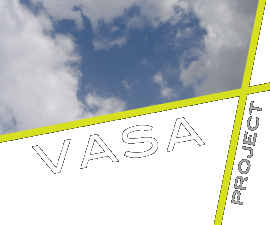
Return to VASA Main Page
VASA Front Page Exhibition #70
VASA Front Page Exhibitions presents the work of emerging and established photographers, video or sound artists.
Ugo Panella (Italy)
"Pediatric Oncology Hospital "
Ukrajina – Kiev
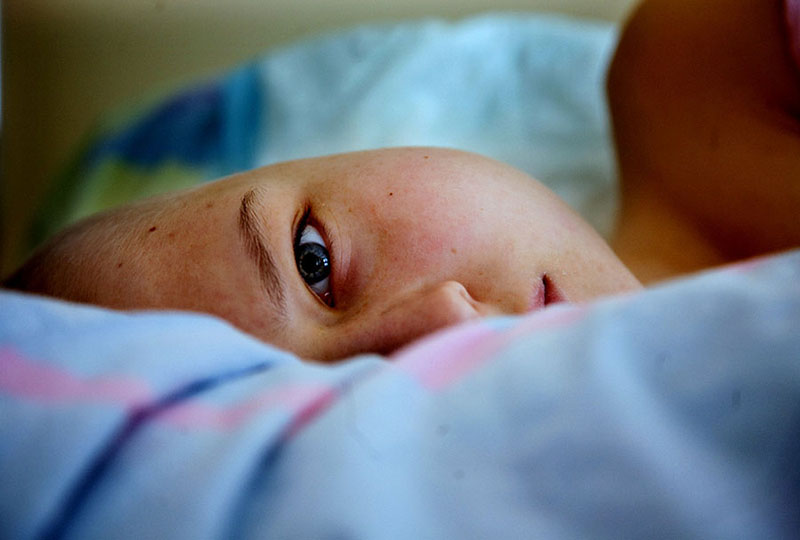 © Ugo Panella
© Ugo Panella
View Exhibition "Pediatric Oncology Hospital"
Curator: Stefania Zorzi
Artist Statement:
English | Italian
On April 26, 1986, at 1.23 am, the Chernobyl disaster occurred at the Lenin nuclear power plant in northern Ukraine.
It was the largest nuclear accident to date, imitating many years later the Fukuschima power plant in March 2011.
The consequences were tragic because the Moscow government (Ukraine was still part of the Soviet Union) denounced the disaster a few days later causing serious delay in the rescue and transportion of the inhabitants of Pripyat out of the contaminated area.
The radioactive cloud leaking from the reactor reached Eastern Europe, Finland, Scandinavia, France, Italy, Germany, the Balkans and the east coast of North America.
There were 350,000 people evacuated, hundreds of deaths and more than 4000 cases of thyroid cancer. Even today, children are born from contaminated mothers who develop cancer in their bones and brain.
In 2009, I was contacted by SOLETERRE, a non-profit organization in Milan that promotes projects supporting pediatric oncology, doctors and healthcare facilities (often dilapidated), in an attempt to improve hospital care and the prospects for successful therapies.
I went to Kiev where Soleterre volunteers work closely with sick children and their families. One morning I entered the hospital located on the outskirts of the Ukrainian capital and became familiar with what would become my home for months.
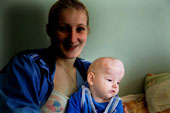 The impression is disheartening ... the crowded rooms, the peeling beds, the hygiene compromised by dilapidated and never renovated structures. Difficult to interpret and testify to everything from a photographic point of view without falling into the easy rhetoric of suffering. In the following days I become familiar with the environment and got to know the children and introduced myself to the parents. I explained to them the reason for my presence and the purpose of the work.
The impression is disheartening ... the crowded rooms, the peeling beds, the hygiene compromised by dilapidated and never renovated structures. Difficult to interpret and testify to everything from a photographic point of view without falling into the easy rhetoric of suffering. In the following days I become familiar with the environment and got to know the children and introduced myself to the parents. I explained to them the reason for my presence and the purpose of the work.
A large exhibition resulted at the Palace of Culture in Kiev summarizing my reportage with the proceeds going to improve the hospital facilities. My photographs, which later appeared in various Italian newspapers, helped a raise public awareness which responded with donations. The donations were used to carry out a renovation program of hospital facilities and subsequently the construction of a "family house" necessary to accommodate the parents of hospitalized children, too poor to afford long stays in hotels.
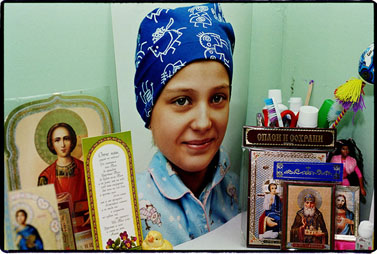 © Ugo Panella
© Ugo Panella
After days of reflection, I was able to find a key to the story that was not focused on the blatant and painful effects of the disease. I preferred to highlight the relationship between parent and child. The hugs and strength of mothers and fathers who tried to give serenity to their children frightened by care and pain. The fortitude of those who knew that their child's life were hanging by a thread and despite of everything, made an effort to smile and console them while hiding their tears in the hospital corridors.
Over the year, each time I returned to Kiev, I found an empty bed of a child who had not survived.
Two years later the photographs were exhibited and entitled “La vodka contro il cancro” (“Vodka against cancer”). The title was due to the fact that many doctors, especially in the countryside villages, did not have the ability and diagnostic tools to recognize tumor pathologies in progress and often recommended medicines and infusions in which they added a few drops of vodka, thinking that the addition of spirits would soothe the pains in the bones that plagued sick children.
The title of the exhibition was not appreciated and was boycotted by the leaders of the Ukrainian Ministry of Health. At the inauguration there were many visitors and the turnout of the public led to a fundraising that helped the hospital to renew its equipment, internal structures and improve the conditions of hospitalized children.
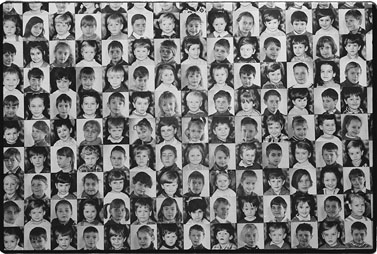 © Ugo Panella
© Ugo Panella
>> View Exhibition "Pediatric Oncology Hospital"
English | Italian
Ugo Panella | Ukrajina – Kiev | Ospedale oncologico pediatrico
Il 26 aprile del 1986, alle 1.23 del mattino avvenne il disastro di Chernobyl presso la centrale nucleare Lenin, in Ucraina settentrionale.
E’ stato il più grande incidente nucleare mai verificatosi fino ad allora e imitato molti anni più tardi dalla centrale di Fukuschima nel marzo del 2011.
Le conseguenze furono tragiche, anche perché il governo di Mosca (l’Ucraina era ancora parte della Russia) denunciò il disastro alcuni giorni dopo con grave ritardo nei soccorsi e nel trasporto degli abitanti di Pryp’jat fuori dall’area contaminata.
La nuvola radioattiva fuoriuscita dal reattore raggiunse anche l’Europa orientale, la Finlandia e la Scandinavia, toccando anche la Francia, l’Italia, la Germania, i Balcani fino alla costa orientale del nord America.
350.000 persone evacuate, centinaia di morti e più di 4.000 casi di tumore alla tiroide. Ancora oggi nascono bambini partoriti da madri contaminate e che sviluppano patologie tumorali alle ossa e al cervello.
Nel 2009 vengo contattato da SOLETERRE, una Onlus di Milano che promuove progetti a favore dell’oncologia pediatrica e supporta medici e strutture sanitarie, spesso fatiscenti, cercando di migliorare le cure ospedaliere e le prospettive di successo nelle terapie.
Vado a Kiev dove Soleterre ha una sede con volontari che lavorano a stretto contatto con i bambini malati e le loro famiglie. Entro una mattina nell’ospedale situato alla periferia della capitale ucraina e prendo confidenza con quella che diventerà per mesi la mia casa.
 L’impressione è sconfortante…le camere affollate, i letti scrostati, l’igiene compromessa da strutture fatiscenti e mai rinnovate. Difficile interpretare e testimoniare il tutto dal punto di vista fotografico senza cadere nella facile retorica della sofferenza. Nei giorni seguenti prendo confidenza con l’ambiente, conosco i bambini, mi presento ai genitori e spiego loro il motivo della mia presenza e la finalità del lavoro. Una grande mostra avrebbe sintetizzato il mio reportage al Palazzo della Cultura di Kiev e i proventi sarebbero serviti al miglioramento delle strutture dell’ospedale. Così avvenne e il mio lavoro, apparso in seguito su varie testate italiane, contribuì a sensibilizzare l’opinione pubblica che rispose con donazioni necessarie a realizzare un programma di rinnovamento delle strutture ospedaliere e successivamente la costruzione di una “casa famiglia” necessaria per ospitare i genitori dei bambini ricoverati, troppo poveri per permettersi lunghi soggiorni in alberghi.
L’impressione è sconfortante…le camere affollate, i letti scrostati, l’igiene compromessa da strutture fatiscenti e mai rinnovate. Difficile interpretare e testimoniare il tutto dal punto di vista fotografico senza cadere nella facile retorica della sofferenza. Nei giorni seguenti prendo confidenza con l’ambiente, conosco i bambini, mi presento ai genitori e spiego loro il motivo della mia presenza e la finalità del lavoro. Una grande mostra avrebbe sintetizzato il mio reportage al Palazzo della Cultura di Kiev e i proventi sarebbero serviti al miglioramento delle strutture dell’ospedale. Così avvenne e il mio lavoro, apparso in seguito su varie testate italiane, contribuì a sensibilizzare l’opinione pubblica che rispose con donazioni necessarie a realizzare un programma di rinnovamento delle strutture ospedaliere e successivamente la costruzione di una “casa famiglia” necessaria per ospitare i genitori dei bambini ricoverati, troppo poveri per permettersi lunghi soggiorni in alberghi.
 ©Ugo Panella
©Ugo Panella
Dopo giorni di pensieri cupi sono riuscito a trovare una chiave di racconto poco concentrata sugli effetti plateali e dolorosi della malattia. Ho preferito mettere in risalto il rapporto tra genitore e bambino. Gli abbracci e la forza di madri e padri che cercavano di dare serenità ai loro bambini spaventati dalle cure e dal dolore. La forza d’animo di chi sapeva che le speranze di vita del proprio figlio erano appese a un filo e nonostante tutto sforzarsi a sorridere e consolarlo…e magari subito dopo, nascondere il pianto nei corridoi dell’ospedale.
Per un lungo anno sono tornato a Kiev e ogni volta trovavo un letto vuoto di un bambino che non ce l’aveva fatta.
La mostra, allestita due anni dopo, ebbe come titolo “La vodka contro il cancro”.
Titolo dovuto al fatto che molti medici, soprattutto nei villaggi di campagna, non avevano la capacità e gli strumenti diagnostici per riconoscere patologie tumorali in atto e spesso consigliavano medicine e flebo nelle quali aggiungevano poche gocce di vodka, pensando che l’aggiunta del superalcolico lenisse i dolori alle ossa che affliggevano i bambini malati.
Il titolo della mostra non fu gradito dai dirigenti del Ministero della Sanità ucraino e la boicottarono ma l’inaugurazione vide moltissimi visitatori e l’affluenza di pubblico determinò anche una raccolta fondi tale da aiutare l’ospedale a rinnovare attrezzature, strutture interne e migliorare le condizioni di degenza dei bambini ricoverati.
>> View Exhibition "Pediatric Oncology Hospital"
About the Artist:
English
Ugo Panella began his career as a photojournalist in the late 1970s the conflicts in Central America. In particular, the civil war in Nicaragua, and later in Salvador. In the end of the 1980s he worked in collaboration with UNCHR in Salvador (High Commissioner for Refugees) on the acts of peace and the laying down of arms by the guerrilla group "Farabundo Martì".
In Bangladesh, Panella documented the fatigue of thousands of men who, in the port of Chittagong, , worked in difficult conditions dismantling cargo ships for two dollars a day.
In Bangladesh, in collaboration with the foreign correspondents of the Republic Renata Pisu, Ugo Panella reported on the condition of thousands of girls disfigured by sulfuric acid because they rejected the "loving approaches" (advances) of violent men. This work was published by major international newspapers and forced the government to change the laws, introducing the death penalty for those who were responsible for similar crimes.
In Italy he worked with the Pope John XXIII Institute of Serra d'Aiello, in Calabria documenting the conditions found in a psychiatric institution where hundreds of people lived in neglected conditions. From this project he published the photographic book "In direzione ostinata e contraria” (“In the obstinate and contrary direction”).
In collaboration with Soleterre Onlus, Ugo Panella reported on childhood cancers that resulted from environmental disasters occuring mainly in Ukraine, Morocco, Salvador, Guatemala and Ivory Coast.
For many years he documented the microcredit projects of the Pangea Onlus Foundation in Afghanistan. His latest work is dedicated to migratory flows in Africa, in particular Mali, Nigeria, Gambia and Senegal.
In 2009 Ugo Panella won the Eugenio Montale prize for photojournalism.
Italian
Ugo Panella inizia la carriera di fotogiornalista documentando i conflitti in Centro america alla fine degli anni ’70. In particolare, la guerra civile in Nicaragua e più tardi, quella in Salvador. In questo Paese ha realizzato un reportage in collaborazione con UNCHR (alto Commissariato per i Rifugiati ) sugli atti di pace e la deposizione delle armi da parte del gruppo guerrigliero “Farabundo Martì “ alla fine degli anni ’80.
In Bangladesh Panella ha documentato la fatica di migliaia di uomini che nel porto di Chittagong, smantellano navi cargo a due dollari al giorno, in condizioni di lavoro difficili.
Sempre in Bangladesh, in collaborazione con l’inviata esteri di Repubblica Renata Pisu, Ugo Panella ha realizzato un lungo reportage sulla condizione di migliaia di ragazze sfigurate dall’acido solforico perché rifiutano le “avances” di uomini violenti. Questo lavoro è stato pubblicato dalle maggiori testate internazionali ed ha costretto il governo di quella nazione a cambiare le leggi, introducendo la pena di morte per chi si rende responsabile di simili delitti.
In Italia ha realizzato un lungo lavoro nell’Istituto Papa Giovanni XXIII°di Serra d’Aiello, in Calabria. Un istituto psichiatrico dove centinaia di persone vivevano in condizioni di abbandono. Questo reportage è diventato un progetto tradotto in un libro fotografico “In direzione ostinata e contraria”.
In collaborazione con Soleterre Onlus, Ugo Panella ha realizzato un lungo reportage sui tumori infantili derivanti da disastri ambientali, lavorando soprattutto in Ukraina, Marocco, Salvador, Guatemala e Costa d’Avorio.
Da molti anni documenta in Afghanistan i progetti di microcredito della Fondazione Pangea Onlus mentre il suo ultimo lavoro è dedicato ai flussi migratori in Africa, in modo particolare Mali, Nigeria, Gambia e Senegal.
Nel 2009 Ugo Panella ha vinto il premio Eugenio Montale per il fotogiornalismo.
Website: https://ugopanella.it
View Exhibition "Pediatric Oncology Hospital"
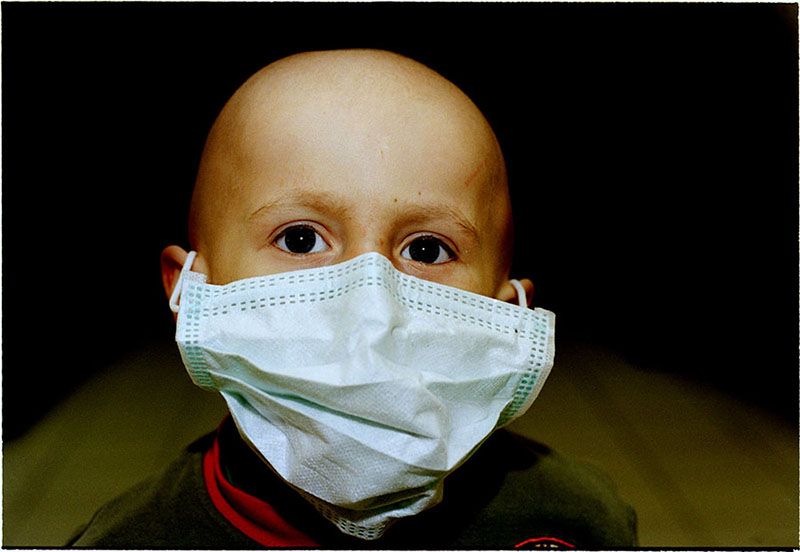 @ Ugo Panella
@ Ugo Panella
